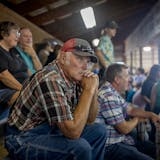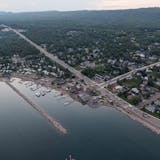DFLer Tim Walz leads Republican Jeff Johnson in the race for governor with less than two months to the election, a Star Tribune/MPR News Minnesota Poll has found.
Walz holds a 9-point advantage over Johnson, at 45 to 36 percent. The poll finds about one in six voters still undecided in the race, and nearly one in five said they were not familiar with the candidates. Walz is a congressman from southern Minnesota, and Johnson is a Hennepin County commissioner.
Walz holds his biggest leads in Hennepin and Ramsey counties, with support from a majority of voters, while Johnson is backed by 27 percent. Walz also holds a comfortable lead in his home turf of southern Minnesota. Johnson leads Walz, but by smaller margins, in the other counties of the Twin Cities area and in northern Minnesota.
Another advantage for Walz: women voters, with whom he holds an 18-point lead. He and Johnson are tied among men. Walz has a huge advantage with voters under age 34 and also leads among those under 49. Johnson has a much smaller lead among voters over 50. Walz also has a sizable advantage with independent voters, 40 to 26 percent.
The poll of 800 likely voters was taken Sept. 10-12, with 40 percent of the callers on cellphones and 60 percent on landlines. Its margin of sampling error is plus or minus 3.5 percentage points. In the sample of voters, 37 percent identified themselves as Democrats, 31 percent as Republicans and 32 percent as independent.
Walz's strength in southern Minnesota illustrates a key advantage for the DFLer: He's staving off the Republican Party's emerging strength in greater Minnesota. After six terms in Congress representing the First Congressional District, the Mankato resident's lead in the poll in his home region is 48 percent to Johnson's 34 percent.
"He has knowledge of what rural Minnesota needs, but also what the metro needs," said Diane Frodermann, 66, a poll participant who lives in Jackson, where she helps run a family hardware and farm supply business.


